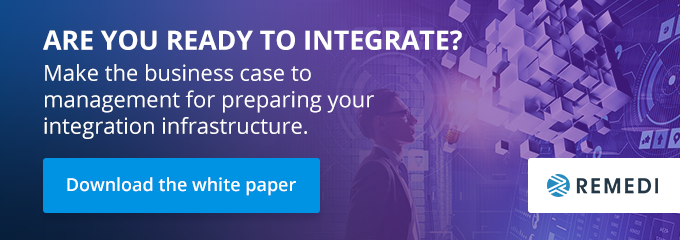
What’s in store for EDI in 2023? Find out in this blog post, where we lay out some of the top predicted EDI trends of the new year, from increased EDI-API integration to EDI for sustainability.
The Future of EDI
The size of the electronic data interchange (EDI) market is set to more than double before the end of the current decade, according to Fortune Business Insights. And forecasted trends reflect that projected growth. EDI, which can be thought of as a standardized digital language that enables accurate, clear, near-instantaneous communication between trading partners’ computer systems, is a critical technology for a wide variety of industries. This includes retail, health care and logistics.
Here are some of the EDI-related developments we are likely to witness in 2023 and beyond.
Increased API Integration
Expect to see EDI and its fellow connectivity solution, application programming interface (API), working together more often. EDI and API share a common goal: the quick, seamless transmission of large amounts of data between organizations and their trading partners. But because the capabilities and methodologies of EDI and API differ, organizations have typically used either one or the other, not both.
This year, however, EDI and API will more frequently be used in concert with one another. API integration will add functionality to EDI and deepen the context of business-to-business integrations, optimizing trading-partner collaboration and making business processes both more efficient and more effective. EDI, meanwhile, will help enable downstream business processes.
As an example, API might help an e-commerce platform gain insight into its inventory so that it can better represent the wares it has available for purchase. Then, when a customer places an order on the platform, EDI sets in motion the automated fulfillment process. In the next few years, EDI-API integration will become even more crucial to positive user experience – and thus, even more crucial to business’ success.
Small Business EDI Adoption
Also on the rise this year is the adoption of EDI by small and medium-size organizations. For cost reasons, many of these businesses will opt out of employing a full-time, on-site EDI team and will instead outsource to third-party companies. The latter are professionals who can address EDI needs with a view toward economy.
In addition to providing EDI services at a fraction of the price of a full-time, in-house team, EDI network providers give organizations a host of cloud-based benefits, such as remote access to their systems from any connected device at any time. Thanks to the cost savings, no longer will businesses that are unable to afford a large cash outlay be kept out of the EDI ecosystem altogether. They will become faster and more efficient – and their processes will become more accurate – thanks to SaaS EDI.
EDI Moving In-house
While some entities will continue to look to outside EDI professionals for fast, standardized documentation exchange, others will find that it makes more sense for them to bring EDI capabilities into their own facilities. Companies that can afford the initial costs of such a move (software and hardware purchases, staff hiring, and benefits) may want to make it, for several reasons.
First, a business or other entity with its own EDI infrastructure and team will be able to take action sooner when it comes to necessary changes, upgrades or fixes to its solution. Second, such an organization has greater control over said system and its trading partner requests. It, therefore, has greater control over its reputation.
It is worth noting, however, that due to the growing popularity of EDI, businesses may find attracting qualified full-time staff to be a challenge.
Increased Demand for EDI Professionals
More EDI-API integration will lead to a more flexible approach that is likely to help ease some of the difficulties of continued supply-chain bottlenecks in the marketplace. This could mean an even greater surge in the demand for experienced EDI technicians, particularly those who are willing to work 40 hours a week, on-site, for a single client.
As a result, these IT professionals – who will probably find themselves continually called upon to bolster their expertise as EDI evolves – could become scarce in the years ahead.
Increased Healthcare EDI Demand
For the past four decades, EDI has seen solid growth, particularly in the logistics and healthcare sectors. In fact, the Health Insurance Portability and Accountability Act has its own EDI standard, which was developed following the 1996 congressional passage of HIPAA legislation in the U.S. The standard aids in health-care-related EDI transactions, and it is largely because of this synergism that healthcare EDI is primed for growth in coming years.
Another reason we are likely to see a rise in EDI use in the healthcare sector? Increasing costs. Higher price tags mean that scaling back spending will become a must for healthcare organizations this year and beyond. Since the industry could save $20 billion by moving to fully electronic transactions, according to the Council for Affordable Quality Healthcare Inc., we can expect to see the demand for healthcare EDI jump.
Growth in Cloud-based EDI Networks
Though it has been in existence for nearly two decades, cloud technology still has room for growth. For example, only a very small percentage of U.S. warehouse-management systems currently use cloud-based platforms. Yet retail companies are more and more frequently requiring specific EDI compliance capabilities, competencies that can significantly expand a company’s product distribution.
With this kind of sales potential, cloud-based EDI networks are likely to see steady growth both in 2023 and in the coming years.
Electronic Invoicing and PEPPOL
Globally, regulatory organizations are seeking ways to expand the use of electronic data, particularly when it comes to invoicing. Mandatory e-invoicing is becoming commonplace; some countries have even eliminated paper invoices completely.
The regularity with which governments issue new regulations has given EDI continued appeal for organizations. For example, the Pan European Public Procurement Online (PEPPOL), an EDI protocol now used for secure business-document exchange worldwide, was developed in 2008 to simplify e-procurement in business-to-government (B2G) transactions.
The PEPPOL framework is now in widespread, common use across Europe, as well as in the U.S., Canada, Australia, New Zealand and elsewhere. Its use is slated to grow further in the remainder of the decade.
Improved Data Exchange Capabilities
The constant growth and monitoring of data supply chains has led to the improvement of business processes. As more organizations deploy EDI, the greater overall visibility, enterprise resource planning and forecasting capabilities will become.
Improved data exchange lets companies take a more proactive approach to management. More businesses will be able to collaborate and expand their operations across borders.
Better access to data will allow companies that specialize in electronic sales to predict demand with greater accuracy, slashing instances of “dead stock” in costly warehouses. This is increasingly important to businesses as product life cycles continue to decrease, making inventory obsolescence more common.
EDI and the Environment
In 2023, look to EDI to become more a part of companies’ environmental, social and governance imperatives. From invoices and shipping updates, to remittances and manifests, the number of business documents that a company generates in a single day can be staggering. It’s no surprise, then, that those organizations still using paper find themselves generating huge volumes of paper waste. EDI software requires no paper, making it a win from an ESG perspective.
In the same way that email and instant electronic chatting have relegated most physical business mailing to history, EDI will continue to usher in a paperless world.
Growing EDI Standardization
No organization that is still using multiple, varying types of document forms and standards can hope to see optimal business success in 2023 or beyond. EDI automatically creates a single standard for all documentation and transactions between an organization and its trading partners. This eliminates extra work, as the company will no longer need to expend hours and personnel resources to manually reconcile the various kinds of documents it sends and receives.
Companies attempting to conduct business without a standard format will find the undertaking to be a clunky, time-consuming one that not many accounting-department employees willingly sign up to do. A business that is EDI-capable sends and receives all its documentation in one organizational standard, clearing bottlenecks, speeding processes and greatly reducing error (not to mention relieving workers of tedious tasks).
Conclusion
In 2023, EDI will continue its evolution – but at a faster clip than it has in years past. The developments and trends we see this year and in the years that follow it, from growth in overall EDI adoption to EDI as means of cutting healthcare costs, are likely to set the tone for the future of EDI in the remainder of the decade.
Are you prepared for the changes? Find out – contact Remedi today for a complimentary integration/EDI assessment.



